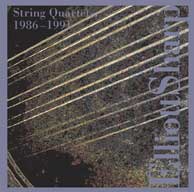
If you've ever hooked a video camera up to a television and watched what happens when you point the camera at the screen, then you are ready to take on Elliott Sharp's string quartets.
What appears is a ghost version of the television, a slightly distorted picture of the picture tube, and within that another, smaller and more distorted version, and another within that and so on. Each image of the television grows more ghostly until somewhere near the middle of the screen, the image begins to spiral out of control and becomes completely abstract. Strange colors and patterns emerge from the center of this spiral, patterns seemingly unrelated to either the video camera or the television. Such is Sharp's use of stringed instruments.
Much of his music is based on overtones. "Tessalation Row", for instance, grows out of a repeated pattern of overtones that are made of proportions that Sharp took from the Fibonacci sequence (1, 2, 3, 5, 8..., where each number is the sum of the previous two). The Soldier String Quartet begins this recording by bowing sixteenth notes in unison, with a thick and resin-heavy attack. Quickly the musicians begin to play out of phase with one another and the overtones rise up from their strings, creating the kind of abstract patterns that emerge from the center of the self-referencing television. So on one level, the ear hears endlessly repeating squeaky strings, and on another an elegant pattern twisting out of them.
With the television, once you've gotten over the tickled fancy of seeing an infinitely repeating television screen, continued exploration leads to the abstract patterns. The fact that the beauty emerges from a glass picture tube is incidental. But for Sharp, the physicality of the strings he writes for is as much a part of his music as the beauty that emerges from the strings.
"Digital," a collection of motif-based improvisational algorithms (which has also been recorded by the Kronos Quartet), makes this clear. The instruments are prepared with a metal strip (Sharp suggests spring steel, bobby pins or pieces of coat hanger) placed through the strings. Once prepared and then amplified, the instruments become more sensitive to the touch. To make use of this, Sharp's instructions call for lots of tapping and percussive techniques, which bring out sounds that buzz and click in the spirit of strings being strings.
The disc is a dense compilation of works like this performed by the Soldier String and the Meridian quartets, works that offer great rewards to repeated listening. But as it's made up of pieces written over the course of a full decade it doesn't make a single statement. Ordinarily that wouldn't pose a problem for an album of shortish pieces, but these pieces are so dense, so specialized in their requirements on the ear, that each new track seems to come on too quickly. Even just a few seconds of silence between tracks would add a lot to the music. Instead, try pressing pause between tracks. These things need to be digested before moving on.
Comments and Feedback:
|



